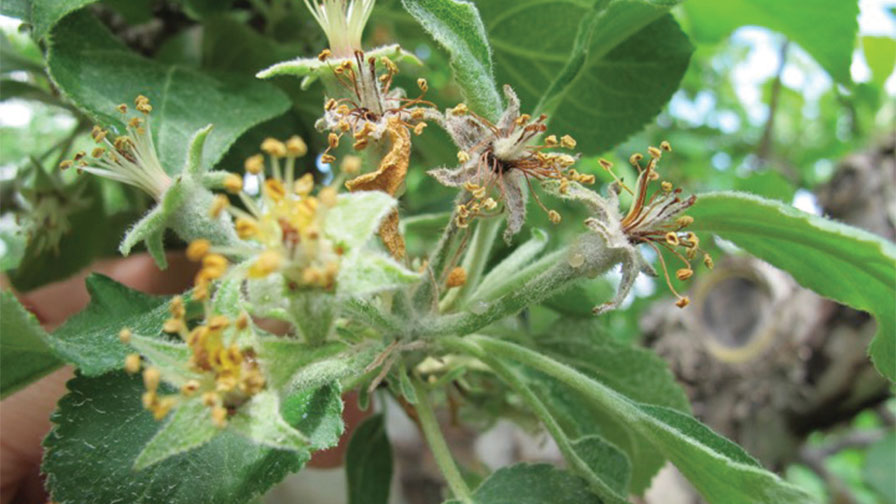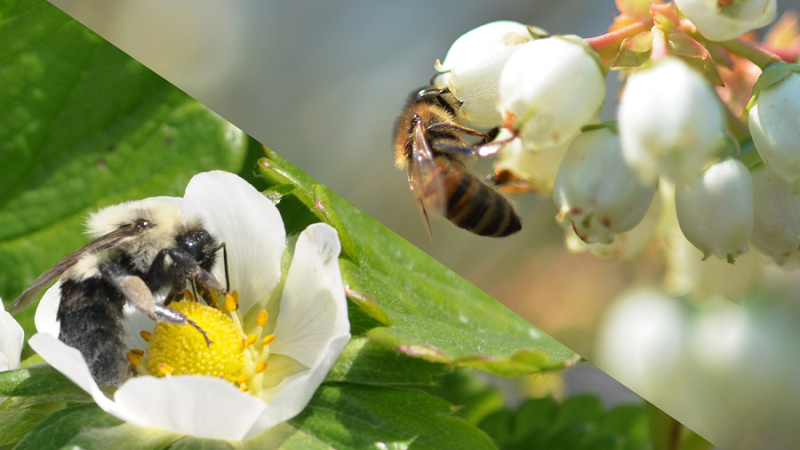Tackling the Challenges of Organic Apple Production Head-on

Blossom blight is the first visible sympton of the Erwinia amylovora bacteria. (Photo credit: George Sundin)
Organic apple production is a tale of two growing regions: the East and the West. With ideal growing conditions in the West, organic production seems like an easy transition. But not so in the East – where conventional apple growers often struggle with disease and fungal infections due to humidity and rainfall.
Organic apple growers lost their tried and true defense against fire blight – oxytetracycline and streptomycin – a few years ago.
Which is exactly why George Sundin, professor in Michigan State University’s Plant, Soil, and Microbial Sciences Department, and Matthew Grieshop, associate professor in MSU’s Organic Pest Management lab, began a three-year USDA Organic Agriculture Research and Extension Initiative. The $464,000 grant project, with a no-cost fourth year, is to examine the products used successfully in the West and see how they best apply in the East.
“We’re having much difficulty in getting any biologicals to work well for us over time. Whereas in the Pacific Northwest, in the dry climates, many of the organic materials seem to work quite well and organics are expanding like crazy out there,” Sundin says. “The weather just favors disease occurrence in our region, with high humidity and rain, generally ideal conditions for pathogens.”
Organic Alternatives
The project looked at Blossom Protect (Westbridge), a yeast spray that blocks the fire blight pathogen from colonizing the blossoms and nectaries of the flower. Sundin says Western organic research from Tim Smith of Washington State University and Ken Johnson of Oregon State University has shown fire blight prevention success with Blossom Protect.
“Data was showing it was working as well as streptomycin in some tests,” Sundin says.
Sundin says in the East he had trouble getting the yeast to colonize and provide effective control. One thought was the flower was already colonized with native bacteria, fungi, and yeast, and those preexisting organisms prevented the Blossom Protect yeast from doing its job.
So Sundin’s project applied Oxidate (BioSafe), to sterilize the flower first before the application of Blossom Protect about four hours later.
“The question was ‘Do we get better colonization of the Blossom Protect yeast and do we get better disease control?” Sundin says Oxidate did a good job of sterilizing the flower, but it doesn’t affect the results of Blossom Protect.
“The summary from four years of data is that disease control was also the same,” he says. “The contact sterilant did not affect the final populations of the Blossom Protect yeast. It was able to attain the same population level.”
A bright spot, though, Sundin says, is he saw consistent data reinforcing the use of less sprays.
“We got the same level of control with two applications at 70% and 100% bloom. That was consistent over four years of testing,” he says. “The upshot is that we got much better results with Blossom Protect than we had previously.”
Sundin also says Blossom Protect is not compatible with organic fungicides targeting apple scab.
“To get the best control when you spray this yeast on at bloom, you can’t really follow it up with an apple scab fungicide. That’s a big problem for us ultimately,” he says. “In a year like this when we’re constantly wet and had a lot of rain events during bloom, scab control would be critical. During bloom that’s a real prevalent apple scab time. Unless a grower was using varieties that were scab-tolerant, then that would be a good fit. But if they weren’t, they could run into some issues.”
Sundin said his team looked at Cueva (Certis), a copper material that is also quite successful out West for organic fire blight control.
“It works pretty well on fire blight for us, but we have a pretty consistent issue with fruit russeting,” he said.
Sundin says there may be a possibility with Double Nickel 55 (Certis) in a mix with Cueva; he’s testing the combo for the first time this year.
So far, Sundin says a new formulation of Serenade called Serenade Opti (Bayer) has good results, which is about 50% control. While that seems low, one thing to keep in mind, Sundin says, is that the trees the team tests the sprays on are inoculated with the fire blight pathogen to ensure a high level of inoculum. Plus, he specifically chose highly fire blight susceptible varieties – ‘Gala’ and ‘Jonathan’ – to test. He says it’s very important to test the organic materials against strong instances of the pathogen, otherwise, it’s hard to see how the products pan out.
“We use high disease pressure because we want to make sure that materials we’re working with work,” he says. “Under those conditions – high disease pressure – 50% control is good. In a commercial orchard the control would be better than what we’re observing in our tests.”
Take Home Message
Sundin says the organic story in the East will always be one with more challenges.
“In our region is it is going to be really difficult for organics unless they’re working pretty exclusively with scab tolerant/scab resistant apple varieties,” he says.
Because of the incompatibility with apple scab fungicides, growers should also be choosy about the varieties they choose for organic production. Sundin suggests growers take a good look at scab-resistant or scab-tolerant varieties such as ‘Honeycrisp’ or varieties that are less susceptible to fire blight. Scab-resistant varieties mean organic growers wouldn’t have to rely on organic scab sprays, which have lower residuals than conventional fungicides.
“If growers are using scab resistant or scab-tolerant varieties, Blossom Protect will be a pretty effective material in this region [for fire blight],” he says. “The Grower is going to have to pick their varieties very carefully, otherwise you’re just going for optimistically hoping that the weather won’t favor these diseases. At least one out of every five years in any particular site, it’s going to be a bad fire blight year, and probably two to three years out of five is the potential for high apple scab risk. We can’t take those risks in our region.”
Plus, Sundin says the makeup of organic fire blight control products makes research a challenge. There are variabilities with living organisms, much like the pathogen, it tries to control.
“It’s a long-term piece of research just to try to understand and lower the variability, reduce the variability of how these work,” he says.
Sundin also suggests growers scout orchards for overwintering cankers, and remove them.
“The key with fire blight is to stay on top of things, no matter if you’ve controlled it well for five years or 10 years, you still have to stay on top of it,” he says. “We have seen that happen where growers say they haven’t had blight on the farm in a decade and it can blow up very quickly.”
Future Research
Sundin says he’s started to work with bacteriophages for control of fire blight. Bacterial phages are viruses that attack the fire blight pathogens. He’s also developing some new combinations of bacteriophages to control the bacteria as well.
Above all, Sundin wants to make sure growers understand that although there are challenges, “we’re always trying,” he says. He says this research has benefits to conventional growers as well, as the growing community may seek to limit antibiotic use.
“We’re still optimistic that we’ll come up with effective alternatives that are useable under all conditions,” he says. ““We still think it’s possible to come up with organic controls in our region, we just have to see and hope that’s true.”










